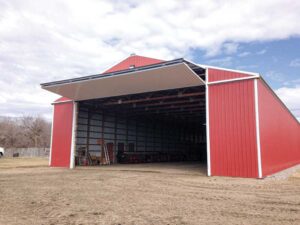Smooth Openings
by Brooke Smith | 21 March 2024 11:00 am

Traditional overhead doors work well for a wide range of buildings, but they have their limits; most can be constructed only as wide as 12 m (40 ft). For large aviation and support equipment, however, 12 m (40 ft) may simply be too narrow. This is when a bifold door presents a better solution. Bifold doors feature a unique truss system that keeps them stable up to widths of 27 m (90 ft), accommodating some of the largest equipment.
Bifold doors allow full use of the opening from the floor to the bottom of the building rafter. A sectional door requires 457 to 610 mm (18 to 24 in.) of headroom on the building’s interior because it is mounted on the inside of the structure. Bifold doors, however, are mounted on the exterior of the building, providing optimal clearance.
For example, say there is an 18-m (60-ft) wide post frame building with a 4:12 pitch roof and 5.5-m (18-ft) side walls. The owner wants to install a 12-m (40-ft) wide door. With a traditional sectional overhead door, they would get only 12 by 5 m (40 by 16 ft) of clearance unless they raised the building to accommodate the 610 mm (24 in.) of headroom needed for the sectional door. With a bifold door, on the other hand, the owner can maintain the same building dimensions and have the full 12 by 5.5 m (40 by 18 ft) of clearance.
For some companies, that extra headspace may not matter, but for others it may be critical to a building’s operation or necessary due to interior obstructions. Additionally, some companies may prefer not to have the door open into the building for aesthetic purposes. If there is an existing opening that will not accommodate a traditional overhead door, bifolds can be retrofitted easily into the structure while maintaining the full opening height.
Another scenario where bifold doors are ideal is if the company desires a seamless look on the building’s facade. Bifolds can be custom-made with the same material as the rest of the structure—such as glass, aluminum, and cedar siding—which allows the door to blend into the building’s exterior.
Standout features
After determining that a bifold door is the ideal solution, there are a few factors to look for in a high-quality door that is safe and easy to use.
Consider units that come standard with just one latch for locking the door closed. A single-latch ultimately saves time from having to go to each doorjamb to lock and unlock the door, which is required with a double-latch system. In addition, look for doors with a safety switch, which eliminates the risk of damage that can be caused when a user forgets to release the latch. An automatic latch is an even more convenient option. It allows operators to open the door with the push of a button—even from the comfort of a vehicle.
Many building owners also value durability and longevity. An all-steel door, one built with heavy-gauge steel tubing and a robust truss system, provides optimal strength and durability even in harsh weather. Cold-formed steel hinges welded to the door’s frame and linked together with cold-formed hinge pins also enhance a door’s durability.
Another way to ensure a rugged door is to look for solid welded construction. Solid welded doors offer a strong frame design with minimal chance of parts loosening over time, resulting in virtually no maintenance.
Beyond the door
When considering a new door for an existing building, component strength is especially critical. This is where getting to know the manufacturer is important. Ensure the manufacturer understands what it takes to make a door that lasts. The manufacturer should inspect the structure—from the jamb and steel header to the foundation—to ensure the building is suitable for a retrofit. Upon inspection, they will design a new steel header and jamb to mount to the face of the building. From there, the manufacturer should work closely with the contractor to ensure the support frame jamb and header system are adequately sized for the existing structure. In addition, using a heavy-gauge steel frame structure allows for the building to handle the stresses exerted by the door. While no frame is truly self-supporting, when a manufacturer and contractor work together, they can develop an effective solution for any type of building.
Jason Myrvik is president at Midland Door Solutions and has more than 20 years of industry experience. His responsibilities include overseeing the manufacturing and installation departments and ensuring the best customer service. Contact him at jason@midlanddoorsolutions.com[1].
- jason@midlanddoorsolutions.com: mailto:jason@midlanddoorsolutions.com
Source URL: https://www.metalconstructionnews.com/articles/features/smooth-openings/